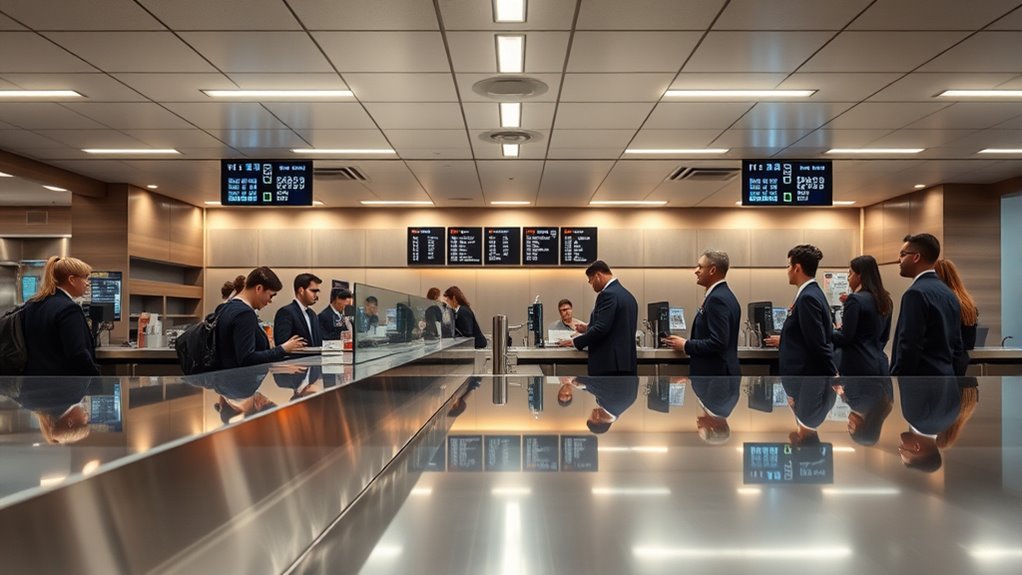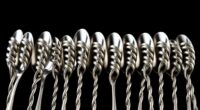To optimize your counter-service lines, analyze customer flow patterns to spot peak times and slow periods. Implement queue management tools like digital signage or self-service kiosks to reduce wait times and improve experience. Adjust staffing levels based on demand, and streamline processes by eliminating unnecessary steps. Train staff to handle queues efficiently and provide personalized service. Keep monitoring performance metrics to identify areas for ongoing improvement—if you explore further, you’ll discover how to refine these strategies even more.
Key Takeaways
- Analyze customer flow patterns to optimize staffing levels and reduce wait times effectively.
- Implement digital tools like kiosks and real-time dashboards for proactive queue management.
- Streamline processes by identifying bottlenecks and automating routine tasks to enhance efficiency.
- Train staff thoroughly to improve service quality, personalization, and product knowledge.
- Continuously monitor performance metrics and customer feedback for ongoing service line improvements.
Analyzing Customer Flow and Peak Periods

Understanding when your customers visit most frequently is essential for optimizing your service line. By analyzing customer flow, you can identify peak periods when demand is highest. Pay attention to patterns over days, weeks, and months to spot trends. Use data from transaction times, foot traffic counts, or digital tools to gather accurate insights. Recognizing these busy times allows you to allocate staff more effectively, ensuring you’re prepared for increased demand. It also helps you plan for slower periods, so you can optimize staffing and resources accordingly. When you understand customer flow, you can reduce wait times, improve service quality, and increase overall efficiency. Regularly reviewing customer flow data helps you stay responsive to changing patterns and seasonal fluctuations. Consistent analysis of peak periods keeps your operations flexible and responsive to customer needs.
Implementing Effective Queue Management Systems

Have you considered how an effective queue management system can transform your service line? It streamlines customer flow, reduces wait times, and improves overall satisfaction. Implementing digital ticketing or self-service kiosks allows customers to join queues without physical lines, giving them control and reducing frustration. Clear signage and real-time updates keep customers informed about wait times and service progress. Train your staff to monitor queues actively and address issues promptly. Automated alerts can notify staff when lines get lengthy, enabling quick adjustments. Consistent communication reassures customers and minimizes perceived wait times. By integrating these systems, you create a smoother, more efficient experience, boosting customer loyalty and operational effectiveness. Effective queue management turns a potential bottleneck into a competitive advantage.
Optimizing Staffing Levels for Efficiency

To optimize staffing levels, you need to analyze service demand patterns to identify peak times and slower periods. Adjust your staff schedules accordingly so you have the right number of employees on hand when they’re most needed. This approach helps improve efficiency while reducing unnecessary labor costs. Incorporating smart scheduling systems can further enhance your ability to respond to fluctuations in service demand.
Analyzing Service Demand Patterns
Analyzing service demand patterns is essential for optimizing staffing levels and ensuring efficient operations. By examining when customer flow peaks and dips, you can identify busy periods that require more staff and slower times that need fewer. Track data over days, weeks, or months to uncover trends, such as seasonal fluctuations or daily cycles. This helps you allocate personnel more accurately, reducing wait times and preventing overstaffing. Use tools like point-of-sale systems or customer logs to gather precise information. Recognizing these patterns allows you to anticipate demand, streamline resource use, and improve customer satisfaction. Regularly reviewing this data ensures your staffing remains aligned with actual service needs, paving the way for a more responsive and cost-effective counter-service operation. Additionally, understanding angel numbers can provide spiritual insights that support better decision-making in resource management.
Adjusting Staff Schedules
Adjusting staff schedules based on demand patterns helps guarantee your team is right-sized for busy and slow periods. By analyzing historical data, you can identify peak times and slow hours, then align staffing levels accordingly. This prevents overstaffing during quiet times, saving costs, and ensures sufficient coverage when customer flow increases. This approach aligns with popular beverage trends, which show a growing consumer demand for healthier and more diverse drink options. Flexibility is key—consider staggered shifts or split schedules to match demand shifts. Communicate changes clearly to your team, emphasizing the benefits of optimized scheduling. Use real-time data to make ongoing adjustments, especially during unpredictable periods. Properly scheduled staff improves service quality and reduces burnout. Ultimately, tailored schedules keep your operation running smoothly, improve customer satisfaction, and boost overall efficiency.
Leveraging Technology for Real-Time Monitoring

By harnessing advanced technology tools, service line managers can gain immediate insights into operational performance. Real-time monitoring systems, such as digital dashboards and data analytics platforms, allow you to track key metrics instantly. This enables you to identify bottlenecks, patient flow issues, and staffing gaps as they occur, rather than after the fact. With live updates, you can make quick adjustments to improve efficiency and patient satisfaction. Automated alerts notify you of critical changes, helping you respond proactively. The use of technology simplifies data collection and analysis, reducing manual effort and minimizing errors. Additionally, understanding the importance of juice cleansing and detox can inspire innovative approaches to maintaining staff wellness and energy levels during demanding shifts. Ultimately, real-time monitoring empowers you to stay agile, optimize resource allocation, and ensure smooth service delivery across the counter.
Streamlining Service Processes and Procedures

Building on real-time monitoring insights, streamlining service processes and procedures guarantees that operational inefficiencies are addressed promptly. You should analyze each step in the customer journey to identify bottlenecks and redundancies. Simplify workflows by eliminating unnecessary tasks and automating routine actions where possible. Standardize procedures so staff follow consistent methods, reducing errors and confusion. Use clear signage and straightforward instructions to guide customers smoothly through the service process. Regularly review and update procedures based on feedback and performance data, ensuring continuous improvement. Incorporating color accuracy considerations into your procedures can further enhance customer satisfaction by ensuring consistent visual quality. By making processes more efficient, you’ll reduce wait times, enhance customer satisfaction, and optimize staff productivity. Ultimately, streamlined procedures allow your counter service to operate seamlessly, providing a faster, more reliable experience for everyone.
Training Staff for Enhanced Customer Interaction

Effective staff training is essential for delivering exceptional customer interactions that foster loyalty and satisfaction. When your team is well-trained, they can handle inquiries confidently, resolve issues efficiently, and create a welcoming atmosphere. Focus on equipping your staff with key skills, such as active listening, clear communication, and problem-solving. Regular role-playing exercises help reinforce these skills and build confidence. Additionally, training should cover product knowledge so staff can provide accurate information. Encourage empathy to ensure interactions feel genuine and personalized. Consider providing ongoing learning opportunities to keep skills sharp. Remember, a knowledgeable, empathetic team positively influences customer perceptions and increases repeat business. Incorporating essential oils knowledge can also enhance staff expertise in health and wellness products, thereby enriching customer consultations.
Measuring Success and Continuously Improving

To guarantee your service line remains optimized, you need to measure performance accurately and seek opportunities for continuous improvement. Start by tracking key metrics such as wait times, customer satisfaction scores, and employee efficiency. Regularly review this data to identify patterns and pinpoint areas needing enhancement. Encourage feedback from both customers and staff to gain diverse perspectives. Use this information to refine processes, update training, or adjust staffing levels. Set clear, measurable goals to gauge progress over time. Remember, continuous improvement isn’t a one-time effort; it’s an ongoing cycle of evaluating, acting, and re-evaluating. By staying proactive and data-driven, you ensure your service line adapts to changing needs and maintains high standards of customer experience. Incorporating performance tracking as part of your strategy can lead to more precise insights and better decision-making.
Frequently Asked Questions
How Can Customer Feedback Be Integrated Into Service Line Improvements?
You can integrate customer feedback into service line improvements by actively collecting their insights through surveys, reviews, or direct conversations. Analyze their comments to identify common issues and areas needing enhancement. Involve your team to implement changes based on this feedback, ensuring continuous improvement. Regularly update customers on how their input shapes service enhancements, making them feel valued and encouraging ongoing engagement for better service delivery.
What Are Cost-Effective Strategies for Small Businesses to Optimize Service Lines?
To optimize your service lines cost-effectively, focus on streamlining processes to reduce waste and improve efficiency. Use customer feedback to identify pain points and fix common issues quickly. Invest in staff training to enhance service quality without high costs. Leverage technology like scheduling tools or online booking to cut operational expenses. Regularly review your performance metrics, adjusting strategies as needed to maximize value while keeping expenses low.
How Do Seasonal Variations Impact Service Line Management Strategies?
Did you know that 70% of small businesses experience seasonal fluctuations in demand? Seasonal variations greatly impact your service line management strategies, requiring you to adapt quickly. You might need to increase staffing during peak times or streamline operations in slow seasons. By analyzing past trends, you can better forecast demand, optimize resource allocation, and make certain of consistent customer satisfaction year-round, ultimately boosting your business’s resilience and profitability.
What Role Does Staff Morale Play in Service Efficiency and Customer Satisfaction?
Staff morale directly influences service efficiency and customer satisfaction. When your team feels valued and motivated, they’re more likely to perform their tasks effectively and provide friendly, attentive service. High morale reduces errors, speeds up processes, and fosters a positive environment that customers notice and appreciate. Conversely, low morale can lead to disengagement and mistakes, negatively impacting the customer experience. Prioritizing your staff’s well-being boosts overall service quality.
How Can Businesses Predict Future Customer Flow Trends Accurately?
Imagine peering into a crystal ball — that’s what predicting future customer flow feels like. To do it effectively, you should analyze historical data, monitor market trends, and use predictive analytics tools. Stay flexible by adjusting forecasts based on real-time feedback. You also need to understand seasonal patterns and local events. By combining these strategies, you can anticipate customer needs and optimize staffing, ensuring smoother operations and happier customers.
Conclusion
By applying these strategies, you transform your counter-service line into a smooth, efficient flow—like a well-orchestrated dance. Imagine customers happily moving through, each interaction seamless and quick, while your staff confidently manages peak times. When you leverage technology and train your team, you create a system that adapts effortlessly, ensuring satisfaction. This isn’t just theory; it’s a proven approach that turns chaos into clarity, making every customer experience a success.









